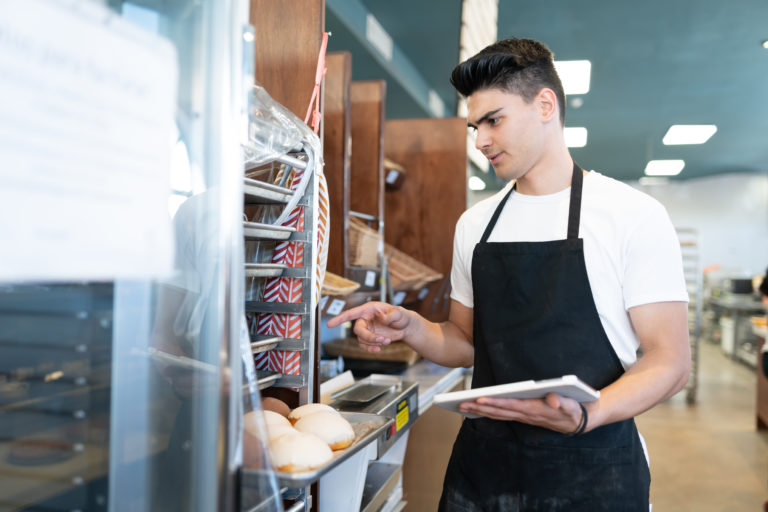15 Restaurant Technology Tools You Need to Power Your Business
Molly Weinberg
5 min read
Sep 13, 2023

Molly Weinberg
5 min read
Sep 13, 2023

If you’re still writing down reservations on a crumpled-up order pad, we don’t blame you; keeping track of everything required to run a restaurant is tough. Luckily, recent advancements in technology — specifically for the hospitality and restaurant industry — mean your restaurant can leverage technology to streamline some of your decision-making and operations.
We’ve compiled a comprehensive list of the 15 most important restaurant industry technology solutions to consider, as well as some of the top vendors in the space. These systems can help across many areas of your restaurant, including:
A restaurant CRM is the centralized hub that all your other restaurant industry technology plugs into. While CRM features vary, the best hospitality CRMs integrate reservation, online order, marketing, guest feedback and POS data all in one. With a CRM, you can track customer data, such as:
Then, you can use this data to build guest profiles that inform your service and marketing efforts so you can personalize experiences at scale, leading to deeper guest loyalty.
Top Solutions: SevenRooms, Eat App, Tock
A POS system is the digital home for your restaurant’s sales transactions. Leverage it to input orders, process payments, keep track of inventory, view sales reports and much more.
However, point-of-sale functionalities differ according to the industry they serve. Look for a POS that serves restauranteurs and operators — specifically a cloud-based solution that connects your POS system (and the data it stores) with the rest of your tech stack.
Top Solutions: Toast, TouchBistro, LightspeedFYI: When shopping point of sale systems, consider a new payment option: handheld systems. Handheld POS systems allow your services to deliver a check and close out the tab in just one visit. At-the-table ordering and payments increase server speed and turn tables faster.
Reservation software makes it easy for guests to book tables for dining at your restaurant and for your restaurant to manage those reservations. The best reservation platforms integrate with your CRM to automatically link the guest’s profile to the booking so you can better tailor their dining experience. Bonus points if the system also sends automated reservation reminders via SMS or email, reducing no-shows and maximizing profit.
There are two types of reservation platforms: direct and third-party.
Top Solutions: SevenRooms, OpenTable, Resy

Playbooks & Guides
Learn More
A table management system helps optimize your restaurant seating layout according to your floor plan. Front-of-house staff can use it to know who’s seated where, which tables are available and which guests are about to turn over.
Best-in-class table management systems use algorithms that test thousands of seating combinations to make sure you assign your customers to the table that will maximize profits. This restaurant industry technology can integrate with your reservation, waitlist, POS, CRM and marketing tools.
Should you need to adjust your floor plan for an event or special occasion, you can rearrange it in the system to view optimal layouts.
Top Solutions: SevenRooms, CAKE, Eat App
Waitlist management software helps restaurants manage walk-ins and let customers add themselves to a virtual waitlist online. Guests can look up your waitlist time online before they come to your restaurant. They can join the list from anywhere by going to your website, scanning a QR code on-site, visiting social media channels or calling your restaurant.
Top Solutions: SevenRooms, Waitwhile, NextME
Pro Tip: When implementing a virtual waitlist, be sure to collect guest emails and dietary preferences at booking — you can leverage this data to engage with guests later. Send them a post-visit survey or invite them to join your loyalty program to encourage repeat visits.
Unless you’re a cash-only operation, you’ll need a card reader to process card and mobile payments quickly. Look for a card reader that accepts the latest payment technologies – magnetic stripes, chips, contactless cards, and mobile payments like Apple Pay or Google Pay.
If your restaurant offers online ordering for delivery and pickup, make sure your payment processor also enables you to take online payments via the internet.
Top Solutions: Stripe, Square, TouchBistro Payments
If your restaurant hosts lots of experiences and special events, an online pre-payment process is vital for booking. This will streamline operations, but more importantly, help restaurateurs maximize revenue through item add-ons and upsells. Just be sure these solutions can sync to your restaurant CRM and guest profiles to provide a complete picture of every guest.
Top Solutions: SevenRooms, Bentobox, Tock
Pro Tip: With any online ordering or pre-payment strategy, be sure to include a cancellation policy to help reduce no-shows.
Make it easy for your customers to place off-premise delivery and takeout orders (and for your staff to manage them) by implementing an online ordering platform. The best online ordering solutions also come with integrated payments, so your restaurant can seamlessly collect card payments for orders placed online.
Like reservation platforms, you have direct and third-party options for this type of technology.
A direct ordering solution is white-labeled with your branding and doesn’t display competitors’ menus next to yours. You also don’t have to pay hefty commission fees with a direct ordering platform, so your business can keep all of its hard-earned profits.
Newer restaurants might opt for third-party online ordering platforms like DoorDash, Grubhub or Uber Eats, whose name recognition and extensive diner network can help expose your restaurant to new customers. Just remember to use your marketing platform to convert your third-party customers into direct customers, so you can get some return on investment on those commission fees.
Top Solutions: SevenRooms, Bentobox, GloriaFood
A KDS, or kitchen display system, is a digital version of a ticket system for your back of house (BOH). When orders are placed via your POS, they appear on a screen in the kitchen. This cutting-edge restaurant industry technology lets you see how long tickets have been open to help your BOH team manage its time and ensure orders come out quickly.
Top Solutions: TouchBistro, Toast, Lightspeed
This restaurant industry technology keeps track of inventory to help you order only what you need to avoid food waste and under-ordering. A restaurant inventory management system can also help you simplify accounting and purchasing and control food costs. It tracks each and every ingredient that is purchased and used within your restaurant.
Top Solutions: Restaurant365, MarketMan, Upserve
For more help on restaurant inventory management, check out our blog.

Blog
6 Must-Know Best Practices for Restaurant Inventory Management
Learn More
Accounts payable software makes the financial side of running a restaurant easier by automating many tedious accounting tasks. It streamlines bill payments, invoice management, and spend management. It also has powerful reporting features that give you insights that power better business decisions.
Top Solutions: Plate IQ, xtraCHEF, Restaurant365
Restaurant employee scheduling software helps you do much more than build shift schedules. It uses historical data, forecasting, and AI to automate scheduling to a high degree of accuracy. This helps to minimize understaffing and overspending on labor.
Some solutions also come with team communication and timekeeping tools. This restaurant industry technology helps restaurant owners manage employee schedules and assignments, ensuring they encourage a good working environment for staff and a pleasurable experience for guests.
Top Solutions: 7shifts, Restaurant365, ZoomShift
For restaurants, marketing is critical for keeping customers coming back. Restaurant marketing software can automate many of the tedious aspects of marketing, such as:
Top Solutions: SevenRooms, Eateria, Marketing 360

Playbooks & Guides
The Restaurateur’s Guide to Marketing Automation
Learn More
If your restaurant hosts private or ticketed events and experiences, you’ll want to add event booking software to your must-have restaurant industry technology list. Event management software lets you sell tickets online, manage bookings, access insights about event sales, attendance and more.
Look for a system that includes digital tracking tools, a CRM integration, promoter tracking capabilities, customizable landing pages, guest tags and secure online payment options.
Top Solutions: SevenRooms, Tripleseat, Perfect Venue
Self-order kiosks, a restaurant technology trend, allow restaurants to meet diners’ expectations of fast, simple service. Some even allow for contactless payment. Plus, these ordering systems allow guests to customize their orders and you can utilize upsell prompts to increase guest spend.
FYI: Self-serve kiosks work best for venues serving up quick bites and fast food that don’t require lots of staff/customer communication.
Restaurant industry technology works best when data is shared between systems, so look for tools that integrate with each other, share information, and enhance each other’s capabilities. Or, look for many-in-one solutions that combine several powerful features in one tool, like the SevenRooms Guest Engagement and Retention Platform. It has everything you need to acquire, engage, and retain more guests.